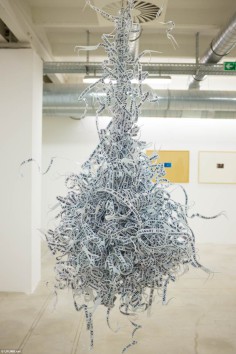GILLES BARBIER
Жиль Барбье

source: artsblogit
Scultore, disegnatore, artista plastico, Gilles Barbier nasce nelle Ebridi nel 1965 per trasferirsi in Francia all’età di 20 anni.
La sua opera è indefessa e prolifica come le sue fonti. Nutrendosi si filosofia, estetica, psicanalisi, storia, scienze, fumetti, a tantissima fantascienza, Barbier si interroga intorno all’ambivalenza e al senso dei multipli, mettendo in dubbio construtti sociali e archetipi con cui si forma la nostra rappresentazione del mondo. Il filo conduttore è una ironia feroce che serve a decostruire e riarticolare il reale più che a problematizzarlo o a criticarlo, come sottolinea egli stesso: la sua realtà è una “fiction”, una nuova realtà che sfugge al principio descrittivo.
Fra le sue ossessioni ricorre il tema della copia (il clone) e la miniaturizzazione (una copia compressa), come potete osservare nella gallery. Nella foto in alto, ritroviamo invece “L’Ospizio”, un’installazione nella quale dei super eroi invecchiati si fanno compagnia a vicenda, mostrandoci un lato oscuro e impudico di questi personaggi.
.
.
.
.
.
.
.
source: artdaily
Gilles Barbier – Gilles Barbier’s work develops a world haunted by science fiction and comics trip. He enriches his work with reading cultivating the contemporary thoughts that conceal history of art, literature, philosophy and sciences. “ I write a lot because it’s a way for me to slow the mind flow sometimes a bit delirious, and try by strategies sometimes a bit paranoiac, to take the sense to the limit. Writing is a tool very practical which organize the things better than language. My texts production prefigures many of piece. I have often a feeling that my pieces are illustrations of these texts. This work method dominated bit by bit. When I show a piece, its preceding work is not visible. […] It pose a real problem because what lead to the exhibition area is only a fragment of what pre-exists : a very narrative pretext, divided and also wrote.” Creator of absurd and complex fictions, master of mental rebus, Gilles Barbier is an atypical artist who cultivates the ambiguity between a “stupid”, derisory and comical attitude, and an “inventor genius, who, by the absurdity, shows the no sense of our society.”
.
.
.
.
.
.
.
source: artinamericamagazine
Since the early 1990s, Gilles Barbier has shrewdly cast himself as the enfant terrible of France’s contemporary art scene. Mixing mordant humor with provocation, he constructs elaborate fictions of the modern world that expose the many fallacies underlying scientific and philosophical thought. His intricate drawings and sculptures, which are often kitschy, show Barbier to be well versed in discourse surrounding the relations between verbal language and visual representation. In a widely quoted statement, he admits with bad-boy crudity: “I try to get language drunk; I try to stuff it, to go down on it, to chew on it. In my drawings and sculptures, I like the idea of emulsion.”
For his recent solo exhibition, “There Is No Moon without a Rocket,” Barbier took cosmological myths and theories as his point of departure. Inherently subjective and arbitrary, in his estimation, such postulates inspired him to delve into his own psychic universe and conjure several alternative three-dimensional worlds (all works 2010). Occupying the front gallery, The World as Thong (54 by 33½ by 73 inches) is a freestanding sculpture that features a thin sheet of blue plastic in the shape of a gargantuan flip-flop’s sole, atop which several plastic volcanic islands jut heavenward. While the outsized form suggests the ocean, its multicolored straps double as rainbows. Directly beneath are similarly sole-shaped plastic shelves (three translucent and one black), strewn with plastic sharks, whales and related marine life. This miniature seascape represents Vanuatu, a South Pacific archipelago where Barbier was born and lived until he was 20. As a boy, he collected flip-flops, which dotted the beaches like “strange meteorites.” Next to this remote tropical paradise hung a large drawing in acrylic on transparent polyester (55 by 73 inches) also called The World as Thong. With comic-book realism, Barbier offered black-and-white studies of the various elements comprising his homeland, around which he inscribed a rambling text recounting the wanderings of an unnamed man (himself?).
Barbier’s other sculptures and accompanying drawings laden with wordy ruminations were equally fantastical. The World as Tree House consists of a living tree around which he assembled tiny wooden domiciles interconnected via staircases and walkways—a kind of sci-fi wonderland. Suspended from the ceiling, The World as Woven Histories resembles a planetlike orb composed of white papery strips on which were written phrases (mostly in English) that yield no coherent narrative. Asshole World, a scatological inversion of a black hole, presents a giant pink plastic anus flanked by two brown slopes, one covered with mini shanties, as in a Brazilian favela, and the other strewn with trash bags and refuse.
Both poetic and profane, these “possible worlds,” as Barbier defined them, wittily wedded fantasy and reality. Even though he has recognized that “the humor certain individuals perceive” in his work “can be interpreted by others as a major violation,” such subversiveness continues to stoke his imagination.

